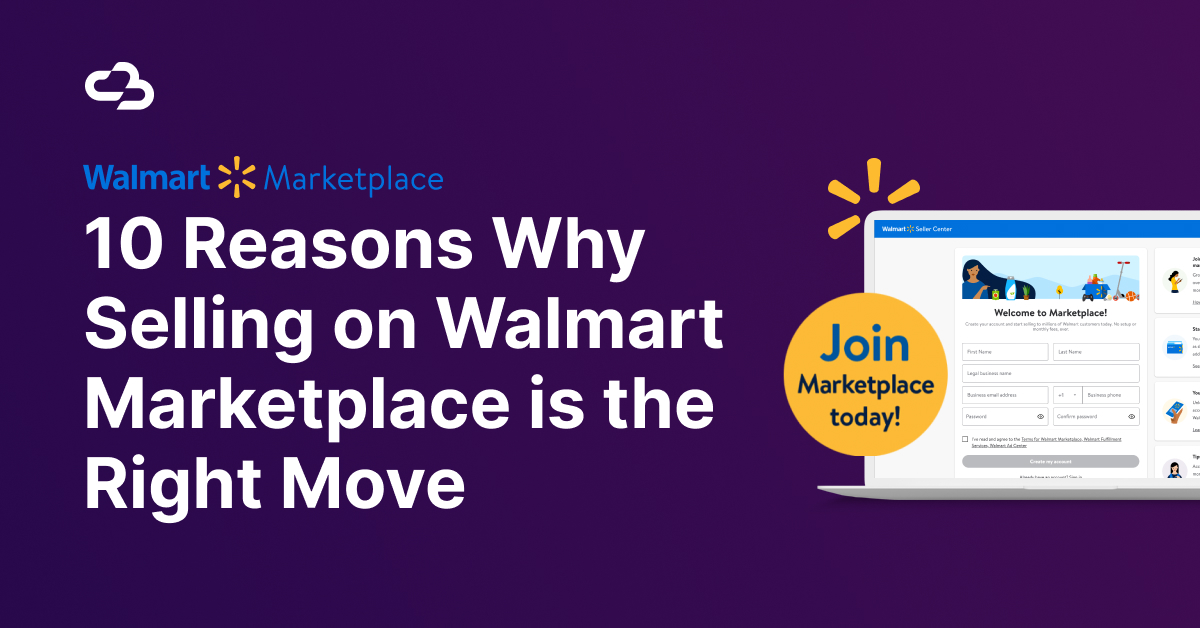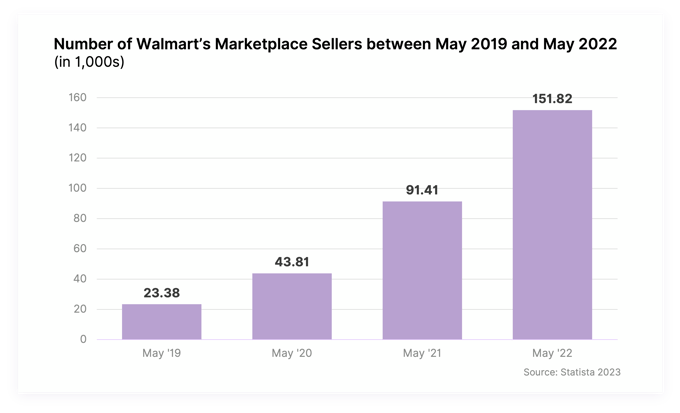[Read time: 7-10 minutes]
Now has never been a better time to start selling on Walmart Marketplace. Amazon, Shopify, and eBay are crammed to the lid with competitors, and Target.com and Costco’s online marketplace are very picky about what sellers can join.
Walmart’s online marketplace is unique compared to other channels: its audience was massive from the jump, its online shopper profile is much different than its in-store, and its barriers to entry are (for the time being) very low.
A recent Harvard Business Review study found that 73% of U.S. shoppers are omnichannel or use multiple channels during their shopping journey. Channel Bakers is a big advocate of putting our clients in front of their customer, wherever they might be. If you’re not selling on Walmart Marketplace, then now is the time to secure digital shelf space.
Why sell on Walmart Marketplace?
In a previous blog we covered how to accelerate your sales on Walmart Marketplace using Walmart Connect. But for sellers who haven’t made the leap to selling on Walmart.com, below you will find what we believe to be the 10 best reasons brands should start selling on Walmart Marketplace.
1 |
Walmart’s Customer Base is very, VERY Big
Walmart is both the world's largest company by revenue and the largest retailer as of 2023. Its presence is felt on every continent, with more than 10,5001 brick-and-mortar stores across the globe and a massive 5,3422 stores in the U.S. alone. Moving to the digital space, Walmart Marketplace pulls up to 110 million unique users per month. Walmart’s changing shopper profile has also added to its large audience. Inflation has caused many college-educated homeowners with children to watch their finances more closely and seek affordable shopping options. Even millennials have become attracted to Walmart’s everyday low prices. Visitors to Walmart.com, at this point, have become virtually identical to Amazon’s average shopper profile. |
2 |
Low Barriers to Entry (as of now…)As of early 2023, Walmart’s barriers to entry are still very low for sellers. This is because sellers do not need to sell their product in Walmart’s physical store to get approved for Walmart Marketplace. This is not the case with a channel like Target, which requires brands to sell in-store before they are allowed to sell on their eCommerce site. Currently, Walmart is still enabling sellers to assort products solely on their online marketplace. However, this could change in an instant. Target had the same policy, but after too many sellers flooded their eCommerce platform, they restricted it to only approved vendors already selling in their physical stores. Now is the time to get approved on Walmart.com! Brands don’t want to squander their chance if the super-retailer decides to change course and restrict who can sell on their dot com. |
3 |
Be an “Early” Player in the Walmart MarketWalmart Marketplace has been rapidly gaining sellers and, as of this article’s posting, is creeping toward 200,000. To put things in perspective, however, Amazon has over 2 million sellers. Although there are already tons of sellers on Walmart, it has not reached the Amazon levels of saturation. If you start selling on Walmart.com NOW, you would still be an “early” player on the site. Competition is not yet as intense as in other marketplaces, meaning it will take fewer ad dollars to be seen by shoppers. Time is of the essence, and sellers don’t want to miss the opportunity to capitalize on Walmart Marketplace’s minimal competition and low marketing costs. |
4 |
Diversifying Your eCommerce PresenceThe analogy of stocks comes to mind; a diversified portfolio is a good portfolio. The same rings true for online marketplaces. Sellers that establish a presence on many channels will take up more digital shelf space, or in other words grow their eCommerce-wide share. Recall that most U.S. shoppers use multiple channels during their shopping journey3. A brand’s potential audience is not all located on one retail channel but many different, overlapping channels. Essentially, Walmart.com's customers may be an untapped market for your brand and your product. A common problem sellers encounter when they diversify their eCommerce presence is share shifting from one channel to another. The key to incremental growth is to target new shoppers and, in turn, grow your brand’s overall online presence. |
5 |
Fee Structure is Seller-FriendlyWalmart Marketplace is a relatively low-cost channel. Most platforms such as Amazon, Instacart, Target, etc., charge a monthly or annual fee on top of additional referral fees. Whether you sold zero or a thousand units, these fees are still required to continue selling on the platform. Walmart, on the other hand, does not charge a subscription fee and only charges sellers a referral fee that varies by product category. |
6 |
The Endless Aisle
Similar to how the lack of subscription fees benefits non-enterprise brands, so does the endless aisle. If a shopper walks into a physical Walmart store, they can choose from 10 different bicycle brands. But on Walmart Marketplace, they’ll have access to over 100 different types of bikes. The shopping experience doesn’t have to end at the store. Say a working mom can’t find the toothpaste brand she likes while shopping in person—she needs only to open her phone and find it on Walmart.com. The endless aisle empowers smaller sellers to enjoy Walmart-level clout without needing to secure an in-store deal. |
7 |
Sellers can Set their own PricesOne of the biggest frustrations brands have with Walmart is their low price thresholds and return policy. Brands selling through a Walmart store would have to dramatically lower their prices to meet Walmart’s standards. Not only that, but Walmart’s generous return policies meant sellers would have to front the bill if a “dissatisfied” customer returned with a half-used bottle of expensive shampoo. Walmart Marketplace is a different world in this regard. Sellers have the power to set their own prices on Walmart.com. That’s right, Walmart merchants are not setting your price—you are. |
8 |
Give Your Customers Free 2-Day Shipping
Free and speedy deliveries are VERY important to modern shoppers. Data gathered from a UPS global survey found that 55% of U.S. shoppers believe free shipping to be the biggest benefit of online shopping4. In the same vein, a RILA report found that an overwhelming 90% of consumers see 2- to 3-day shipping as the baseline delivery promise5. Walmart, like Amazon, also offers free shipping and 2-day delivery. The crucial difference is that unlike Amazon, where it is Amazon Prime members who have access to free 2-day shipping, Walmart gives this benefit to ALL shoppers but to only a select number of sellers. Sellers must meet certain criteria if they want to offer free 2-day shipping to their customers. Sellers who earn this merit-based sales tier will stand head-and-shoulders above the competition on Walmart Marketplace. |
9 |
Optional Fulfillment Services
Walmart Fulfillment Services empowers sellers to piggyback off Walmart’s expensive infrastructure and delivery fleet. Walmart Fulfillment Services essentially gives sellers all the advantages of Walmart’s facilities for a fee. WFS relies on a well-established fulfillment system, so the pricing for storage and shipping is straightforward, and tracking your stock in the warehouses or on the road is equally easy and stress-free. Finally, and bleeding into point #8, sellers who use Walmart Fulfillment Services automatically qualify for 2-day shipping. |
10 |
Leverage the Power of Walmart’s Brand
Walmart is undoubtedly a heavy hitter in the eCommerce space. But when you consider the brand beyond its dot com, it's a titan of commerce. If sellers can make it through Walmart Marketplace’s selection criteria, they’ll instantly gain credibility and share a piece of Walmart’s brand value. Consider shopper hesitation when buying from a third-party site—they may not trust your brand enough to hand over their credit card information, address, and phone number. Walmart.com has already earned shopper confidence. And, as a Walmart online seller, that confidence will be extended to your brand too. |
Ready to Start Selling on Walmart?
Now that you know what Walmart Marketplace has to offer, consider signing up and starting the approval process. Still have questions? Our eCommerce experts have the answers and would be happy to help you with all things operations and online marketplaces.
Sources:
2. Statista, March 2022
3. Harvard Business Review Study, 2021
4. UPS, 2018 Global Survey
5. Retail Industry Leaders Association, Retail Insights, 2021






.jpg)





